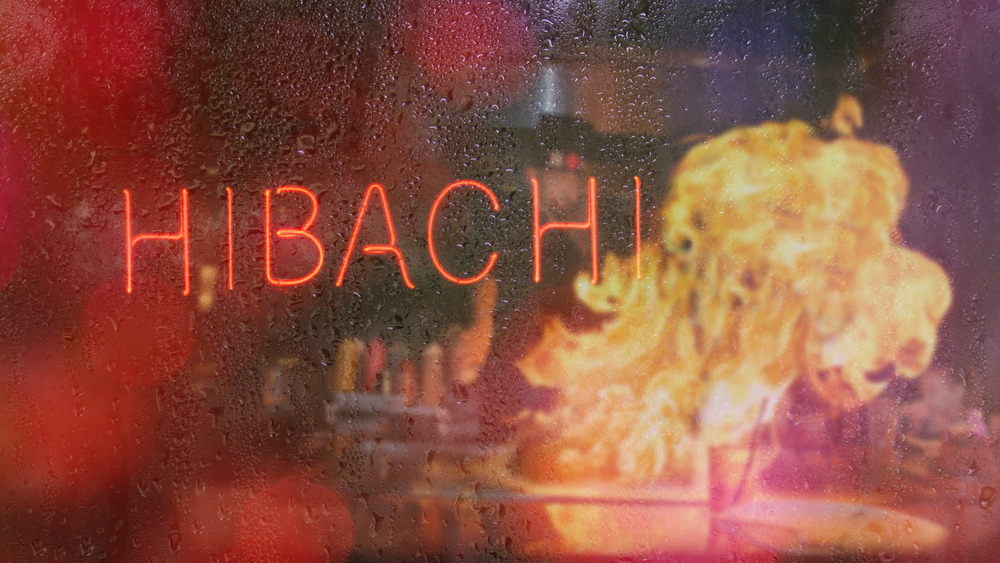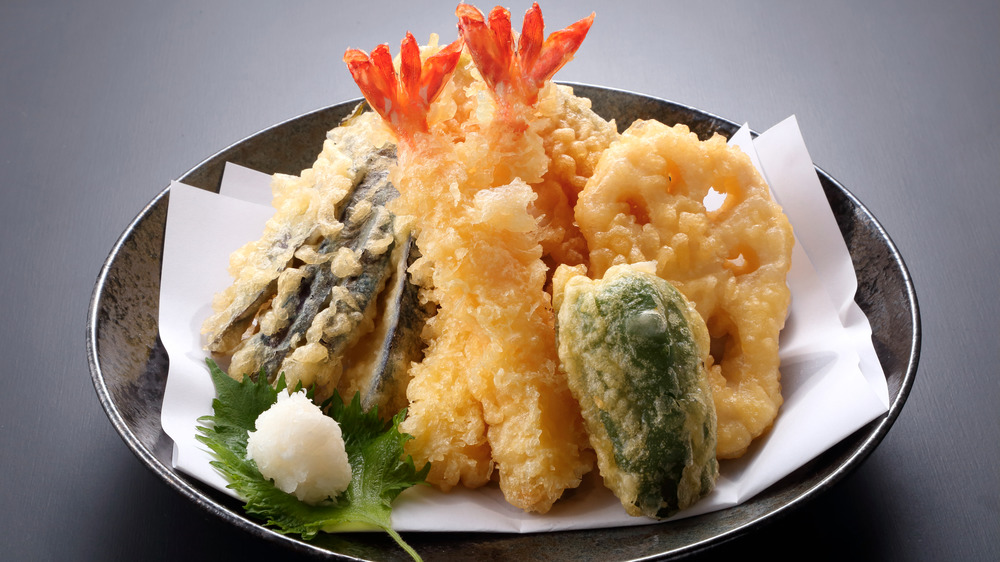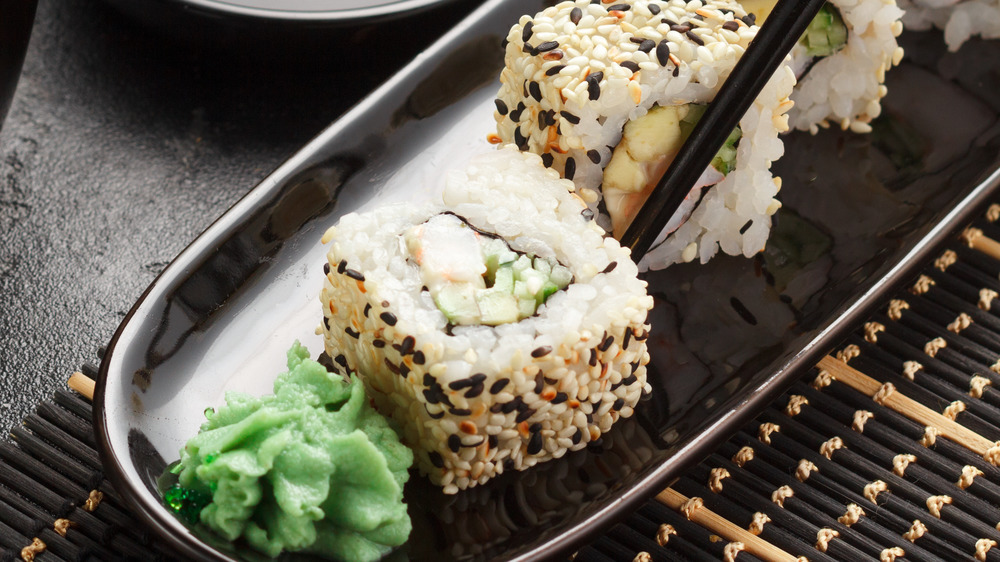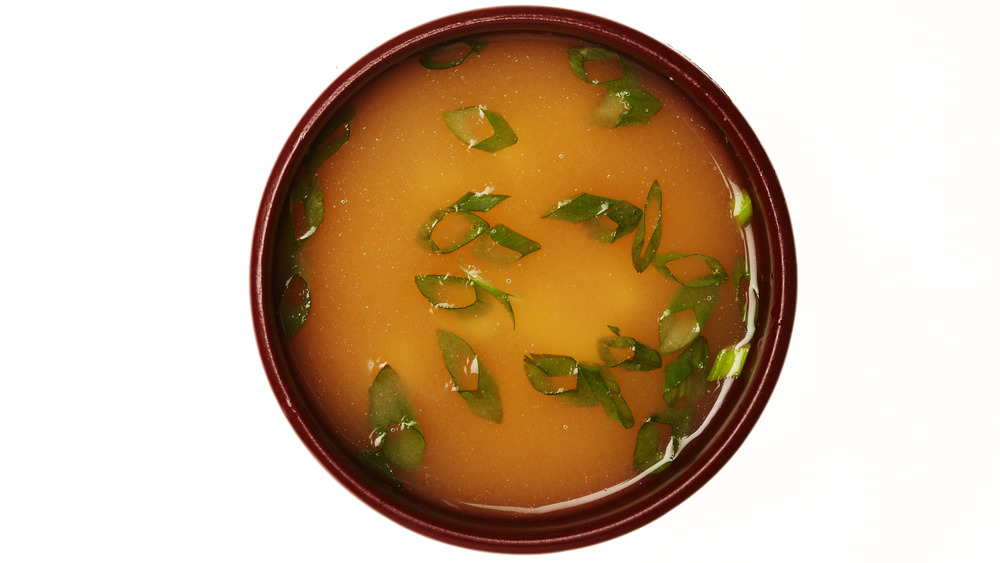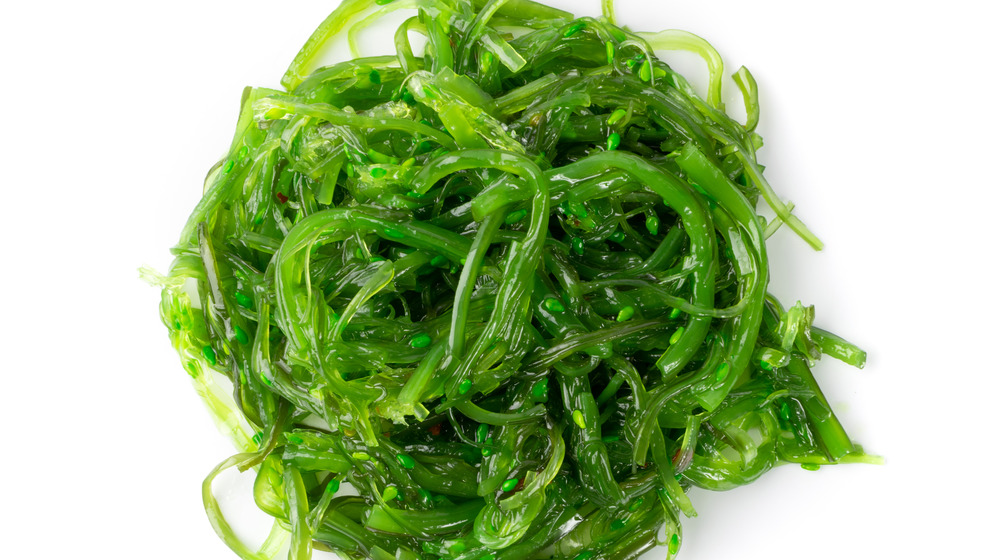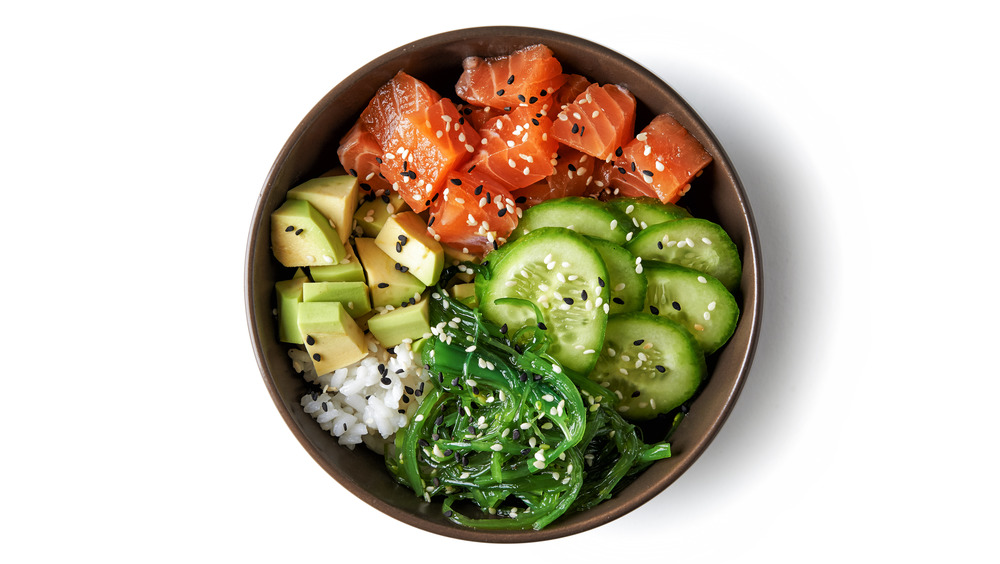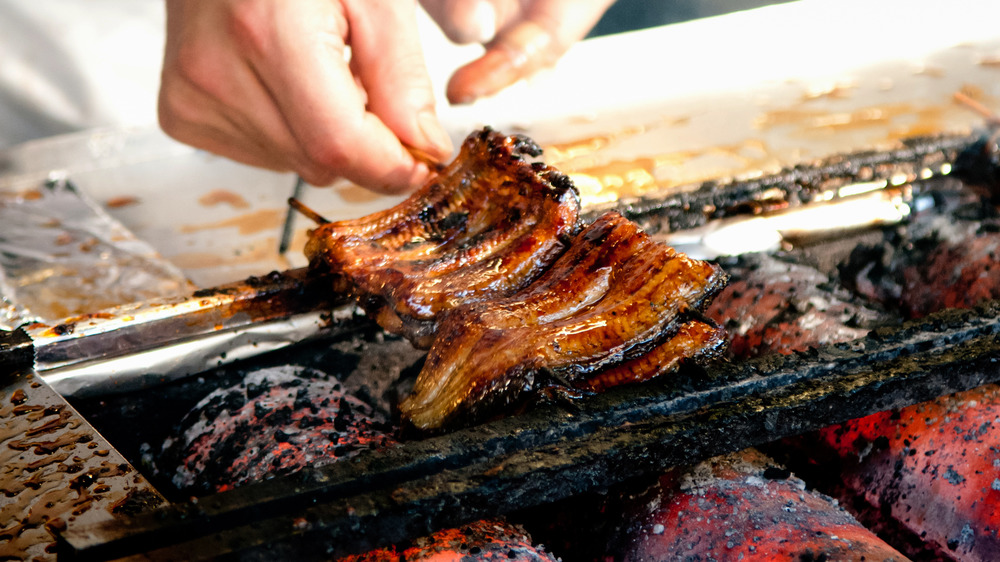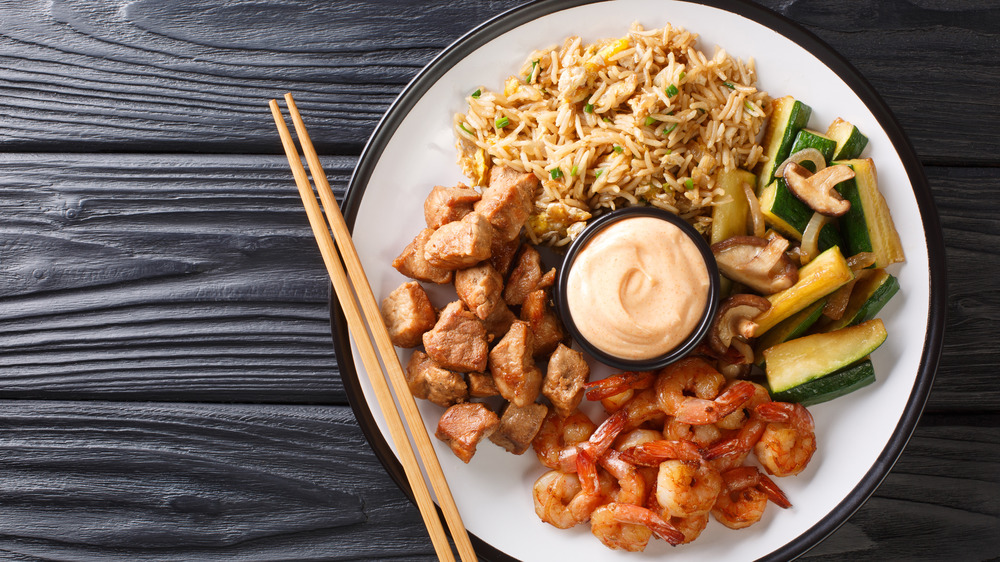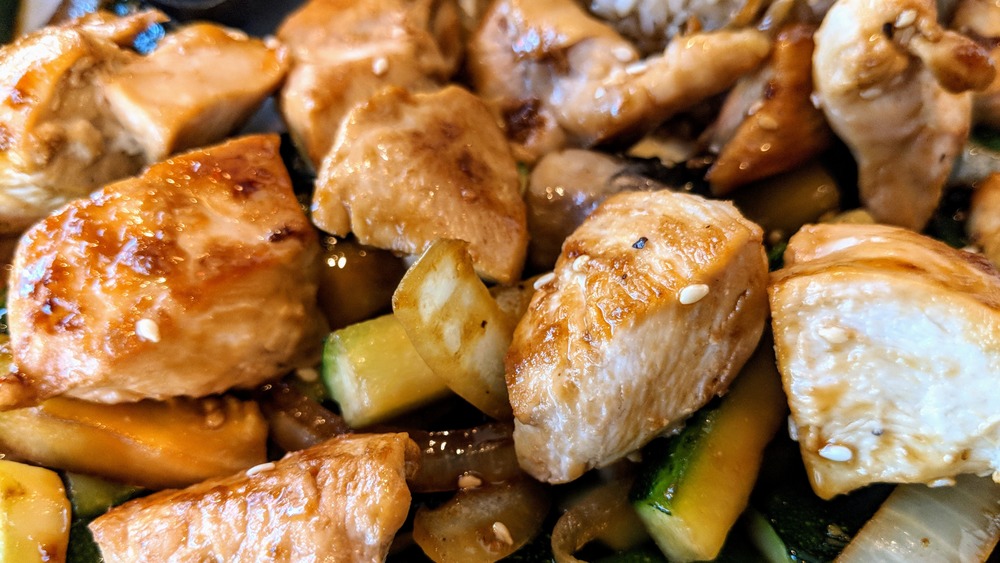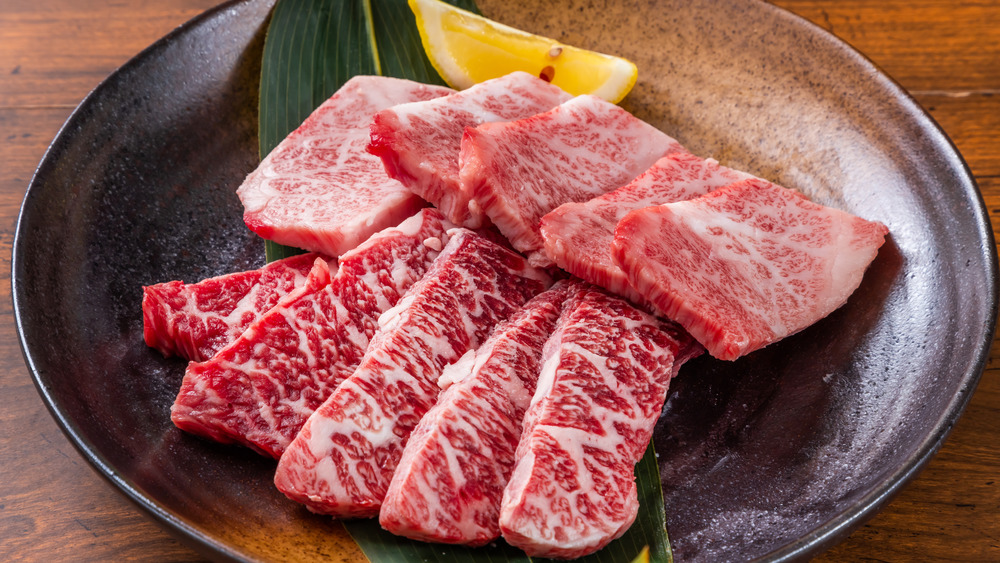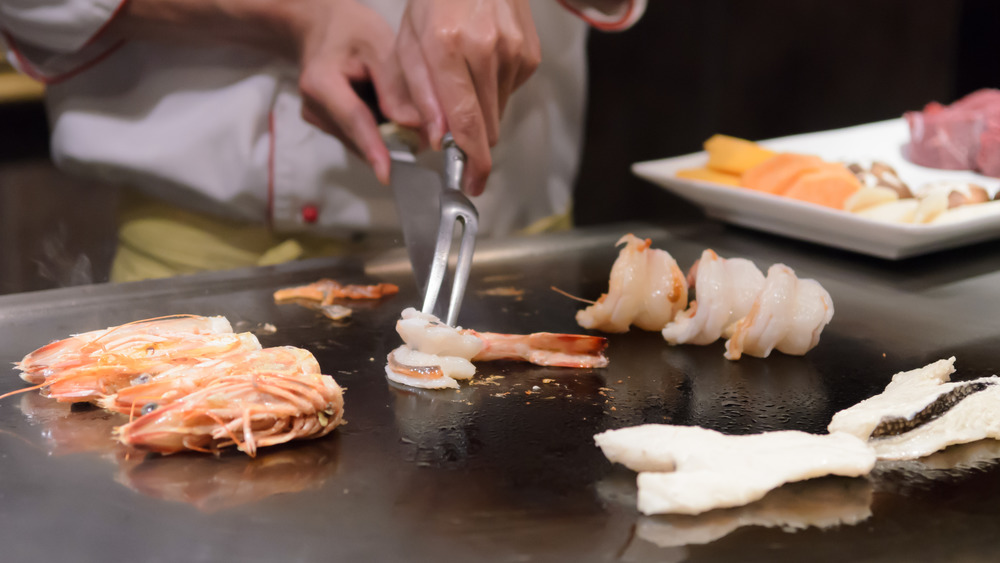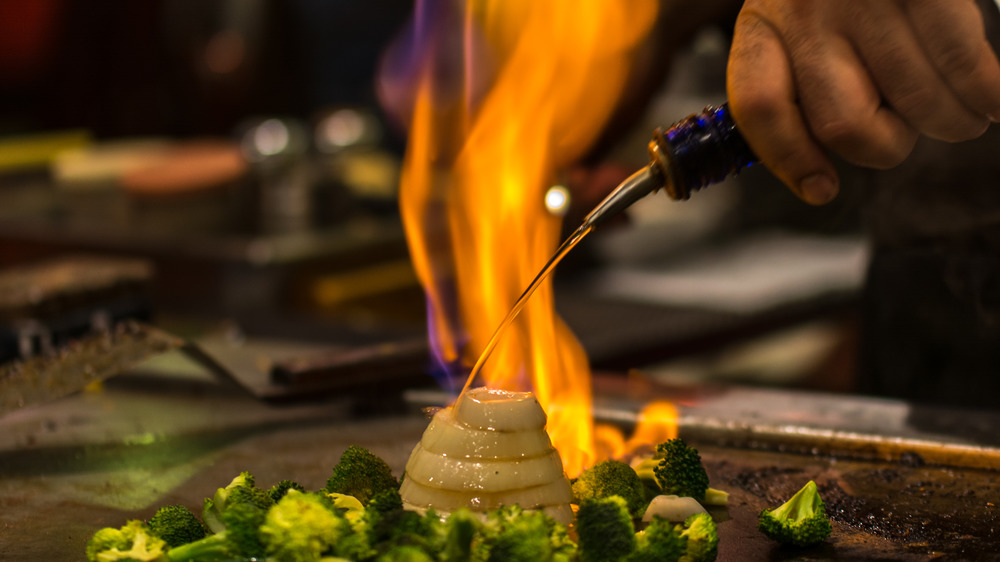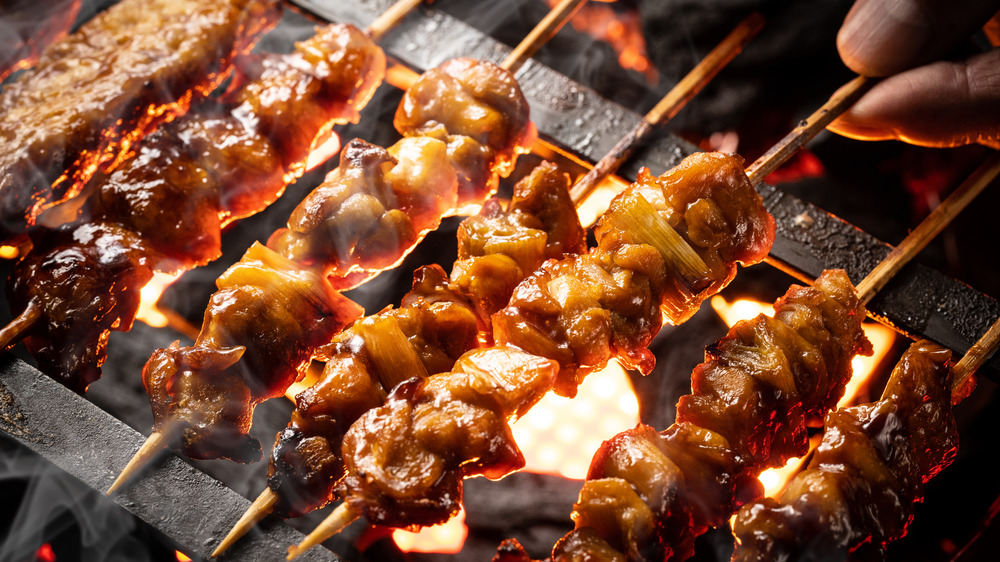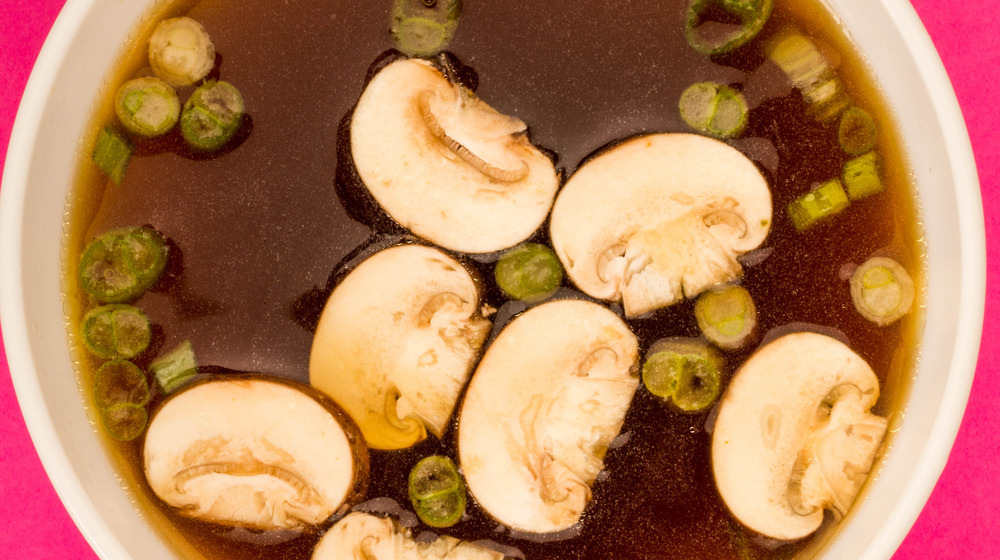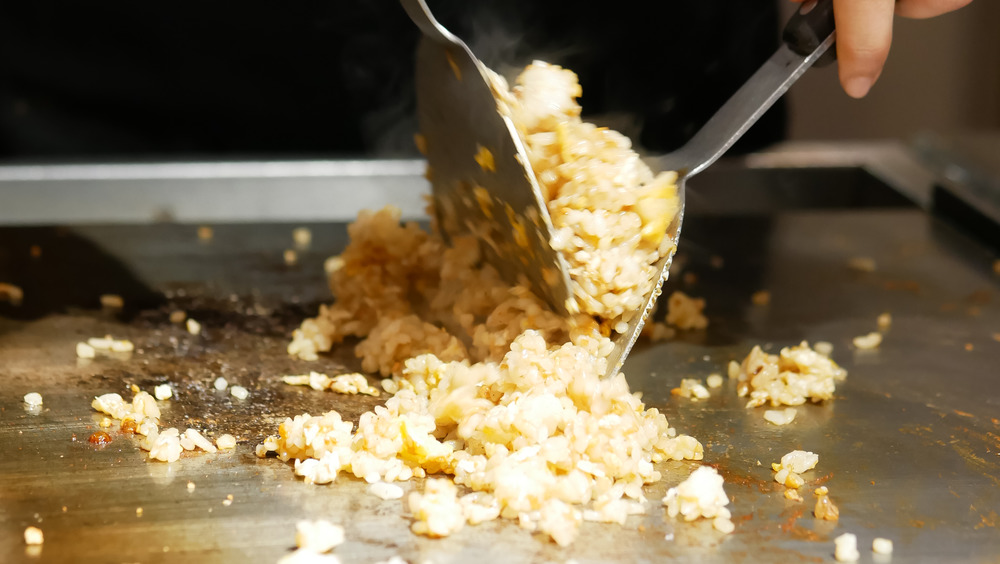6 Things You Shouldn't And 8 Things You Should Order From A Hibachi Restaurant
We may receive a commission on purchases made from links.
Before we get to the food, let's be clear on the differences between hibachi and teppanyaki. Hibachis are a small type of grill heated by charcoal or wood, while teppan grills are flat-top grills heated by gas. Teppanyaki cooking might have originated with hibachi grilling, but in America, teppanyaki and hibachi restaurants are generally thought of as the same thing. Essentially, both terms refer to the Benihana-style restaurant experience where a chef cooks your grilled meal right in front of you, and dinner often includes a culinary show.
The main culinary attraction — aside from volcanic onions and fried rice hearts – is usually meat and shrimp, with some dipping sauces and appetizers, like edamame. While that might sound like expected Japanese restaurant fare, teppanyaki and hibachi restaurants menus are not exactly the same as menus from your favorite sushi or shabu shabu spots. And that's where this list of what you probably should and shouldn't order at a hibachi or a teppanyaki restaurant comes in handy.
Think of this list as a two-for-you. Anything you wouldn't order at a hibachi place, you shouldn't order at a teppanyaki place and vice versa. We're looking at you, Hawaiian poke!
Don't Order: Hibachi Restaurant Tempura
First of all, the focus of a specialty Japanese grill restaurant is on the grill. Yes, tempura can be delicious — there are even Michelin-starred tempura restaurants in Japan (via Saveur) — but unless your favorite hibachi restaurant is known for its non-greasy batter and reputable tempura chef, you're better off steering clear of the deep-fried shrimp, sweet potato, zucchini, or other vegetables coated in a batter that may or may not be actual panko. That's because tempura is hard to get right.
Two of the biggest potential problems with cooking tempura are temperature and quality of oil. Chef Sung Park of sushi restaurant Sake Rok in Las Vegas told Insider that tempura will often be fried in old oil. According to Epicurious, frying in old oil can make for soggier and greasier food if not done correctly, and older oils can have strange odors. According to The Post Star, the right temperature for frying tempura should be between 340 and 360 degrees Fahrenheit, and you also have to consider how many pieces of tempura you're frying at any given time, because that can affect the temperature. See? It's hard!
One order of the vegetable tempura appetizer at Benihana clocks in with 43 grams of fat (via Eat This, Not That!), so that's yet another reason to stick to the grilled specialties that Japanese grill restaurants are known for.
Don't Order: Hibachi Restaurant Sushi
If you want sushi, go to a sushi restaurant. Like tempura, sushi is hard to make really well — probably even harder! And a place specializing in hibachi-grilled foods is probably not going to hire the top sushi chefs just so they can hang out in the shadows for specialized sushi. If a sushi restaurant has really amazing sushi, they'll want to show it off.
You also have to consider that fish used for sushi should be of the highest quality, and sushi restaurants are usually more reliable in that regard. It's considerate of a hibachi restaurant to have more on the menu than just items coming from the grill, in case someone is dragged to a party and the restaurant wasn't their choice. But if you know a restaurant isn't going through as much volume of sushi as a sushi-specific restaurant would, you'll most likely want to steer clear of ordering this raw fish.
Restaurants that don't specialize in sushi might also be more likely to provide specialty rolls with lots of mayo, salt, sauces, and preservatives — which is not exactly traditional fare or that good for you. As Eat This, Not That! reports, the Chili Shrimp Roll from Benihana has 31 grams of fat and almost as much sugar as a can of Coke!
Don't Order: Hibachi Restaurant Miso Soup
There's nothing wrong with miso soup. In fact, a great miso soup can be the indicator of a great Japanese restaurant (via Insider). But there are a lot of ways to make a subpar version that ends up being as lackluster as a salty bowl of hot water.
And most hibachi or teppanyaki grills are probably not going to be creating a dashi broth from scratch with bonito flakes infused for just the right amount of time. They're probably not incorporating just enough of an ideal kind of miso paste either, and they're probably not carefully shredding just enough strips of green onion for that pungent aroma and umami-rich broth (The green onion isn't mandatory, but the dashi and quality miso are).
The most important reason to not order miso soup at a teppanyaki or hibachi restaurant, though, might be that it just isn't as tasty as the onion soup that a lot of hibachi restaurants serve (see below).
Don't Order: Hibachi Restaurant Seaweed Salad
It's easy enough to buy dried wakame, reconstitute it with water, and then season it yourself. But it's even easier to just buy seaweed salad frozen and defrost as needed — and that's what a lot of Japanese restaurants do to save time and effort. But doing that means there can be a lot of preservatives included that you might not want. And while there are plenty of more natural brands of seaweed, those are probably not what your favorite restaurant is using.
In an article for Naturally Savvy, RHN Andrea Donsky writes that when she asked her Japanese friend to read the ingredients on the premade seaweed salad at a sushi restaurant one night, the ingredients included high-fructose corn syrup, two types of glucose, vegetable fat and oil, hydrolyzed protein, acidulant and yellow, and blue food coloring. That doesn't sound like the healthiest salad!
And if it's bright neon green, that's an indication that your appetizer might have come from a pre-seasoned tub (via No Recipes). You're better off sticking with the grill.
Don't Order: Hibachi Restaurant Poke
Sushi is one thing, but poke probably has no place on a hibachi menu. Never mind that you don't feel like yakitori. Never mind that you don't care for grilled shrimp. Never mind that you really just want the creaminess of avocado and some likely non-environmentally-friendly salmon in a mayo-heavy sauce. Poke, a dish that emphasizes fresh and free-range fish and good-quality rice, doesn't belong on a hibachi grill restaurant's menu.
Poke was once a trending dish, but that's long since ended (via Eater). Even if it were still popular, this dish of cubed raw fish on rice with a bunch of toppings (oh look, more commercial seaweed salad...) and sauces that has a loose association with Asian food (it's Hawaiian with Japanese influences, via Hawaiian Airlines) is best left to the experts that specialize in raw fish. Would you also put tiradito on your hibachi menu? Maybe in Peru, but at Benihana?
A great restaurant doesn't need to offer absolutely everything for everyone on its menu. So if you really want poke, go to a poke restaurant instead of a hibachi grill.
Don't Order: Hibachi Restaurant Grilled Eel
Don't you love that slimy, barbecued eel that comes in a thick, sweet teriyaki sauce? Unagi is a sushi staple, and at a grill restaurant it can be even better because the grill adds extra smokiness.
But did you know that the eel on the menu is probably not sustainable and also probably came frozen, precooked, and pre-marinated? Ninety percent of the freshwater eel population in Japan has disappeared (well, was eaten) over the last three generations, and the Anguilla Japonica is now an endangered species. And it's not just in Japan. The Monterey Bay Aquarium Seafood Watch program lists eel as a species to be avoided.
There are some American companies trying to harvest eels sustainably, but your neighborhood hibachi place might not be buying those versions, breaking them down themselves and grilling them to order. More likely, it's using unagi that comes in vacuum-sealed from China, Korea or Japan (via Reddit).
Order: Hibachi Restaurant Yum Yum Sauce
Yum yum sauce has become an iconic part of any hibachi dinner. The truth is it's not particularly Japanese. As cookbook author Nancy Singleton Hachisu told NPR, it's "basically pink mayo."
The original version, bottled by Terry Ho, includes soybean oil, sugar, corn syrup, egg yolks, vinegar, salt, mustard, dehydrated garlic, hot sauce, tomato paste, red pepper, paprika, natural and artificial flavor, potassium sorbate and sodium benzoate (which are preservatives), propylene glycol alginate, calcium disodium EDTA (to protect flavor), polysorbate 80, white pepper and "spice" (via Open Food Facts). But a lot of restaurants make their own (without all the preservatives, unless those are already in the commercial mayo they use) and add a ton of butter, which is clearly more delicious.
You know this sauce might not be healthy for you, but it's like the garlic sauce with your shawarma or the Big Mac sauce with your burger — essential, despite how you might feel later. Though yum yum sauce generally comes with your meal, if it doesn't, it's your responsibility to order it.
The other now-traditional sauce often served with hibachi is what people call "brown sauce" or "ginger sauce," which is usually made with ginger, soy, vinegar, and sugar. Commercial versions would have a lot more preservatives than that, but like the yum yum sauce, a homemade version is pretty easy!
Order: Hibachi Restaurant Grilled Chicken
According to one past hibachi restaurant employee, grilled chicken is one of the only items that needs to be cooked on a lower heat on the hibachi grill (Reddit), and it is often the most popular menu item.
On grills where the charcoal flames are coming up between the grill grates, you're going to get a clean, smoky flavor without any lingering smell of gas, which lets natural flavor come through. You can't control where the flames kiss the meat as easily, but that's all part of the art.
Still, if you're at a hibachi restaurant that uses a flattop grill (which is really a teppanyaki restaurant, but let's not get too technical), you should still order the chicken. The breast will be more dry than thigh, though, so definitely go with thigh if you're at a place with grated grills, since much of the fat will drip off and you'll still end up with a tastier piece of meat. At a flat-top grill, you could probably go either way.
Order: Hibachi Restaurant Specialty Beef
The Japanese word for meat grilled over an open flame is yakiniku, and ordering any kind of steak is going to be a good decision at a hibachi restaurant. The biggest upside of charcoal hibachi grills over gas-powered grills is that the charcoal gets so hot that it's generally easier to end up giving meat a crispy crust and tender interior. And if you're into specialty meats, a Japanese grill restaurant might be the place to go, though you should know what exactly you're ordering first.
According the Holy Grail Steak Co., only certain grades of cattle from a place called Kobe produce authentic Kobe beef, which is what makes it so valuable. Kobe beef is also a regional style of Japanese Wagyu, and "Wagyu" refers to the breed of cattle, Bon Appetit reports. So, you can have Wagyu beef from the US, but you can't have Kobe beef from the US. If that doesn't make sense, think about sparkling wine, which can be made anywhere, but Champagne can only be made in the Champagne region of France.
That being said, Bon Appetit reports that if your neighborhood hibachi place advertises Kobe beef, it might not actually be Kobe beef, even if it's expensive — it can be advertised Wagyu and be authentic, though. Either way, it should be wonderfully fatty and hopefully some of the best beef of your life at whatever high price your restaurant is charging.
Order: Hibachi Restaurant Grilled Seafood
Another popular hibachi item is grilled shrimp, and while these juicy, salty, jumbo crustaceans are delicious off the grill, you might want to check on the sustainability of the ones served at your favorite hibachi restaurant. Farmed shrimp from overseas are often very polluting and even associated with human rights abuses (via PCC Community Markets). A lot of U.S. grown shrimp are relatively sustainable, but some are certainly better than others. And how will you know if something is sustainable? Ask your chef first. If they can't tell you where the shrimp is coming from and how sustainable they are, there are other options for your hibachi dinner. Other sustainable seafood options include certain types of cod and crab, mackerel and scallops, for example.
Seafood dishes are a great dinnertime option because their preparations are often simple and they're relatively healthy, at least compared to a lot of oily-heavy fried rice and noodle dishes, delicious though they can be. Mmm... Omega 3's.
Order: Hibachi Restaurant Volcano Onion
Cut thick, circular slices from the outside of a large onion. Stack the slices on top of each other on a hot flat-top grill so they look like a volcano, pour oil and high-proof alcohol into the hole you left on top, and light it on fire. Actually, don't: This is not something you'll want to try at home.
It's not really a volcano, because the onions are stacked so tightly that the oil and alcohol don't seep out, and what you get is fire shooting up the top, but on the other hand, the size of the flame can range from tame to well, as thrilling as fireworks. And after the flames subside, you'll see a trail of thick smoke to close the show, amid a round of applause from your fellow diners.
You've got to hand it to the well-trained chefs who can properly stack those onion slices, kind of like a juggler who doesn't drop that third, fourth or fifth ball. But the "volcano onion" is just a fun stage trick and not some sort of culinary specialty. Yes, people like anything flambéed, because that charred, smoky taste can be delicious, but at a teppanyaki or hibachi restaurant, that's not exactly the point. The volcano onion is part of what hibachi restaurants were created for: to entertain diners in the West. So, whether or not you're eating the onion, go ahead and place an order and enjoy the show!
Order: Hibachi Restaurant Yakitori
Skewers! Basically, you should order every kind of skewer on the menu if you're at a hibachi restaurant with grill grates. The fat from the meat drips out and the pieces of chicken, beef, shrimp, and pork will be delicious. A little dipping sauce on the side is handy for variety, but most likely your tender piece of skewer meat will also be nicely seasoned.
You should also know that yakitori can be made with a wide variety of meats, and chicken liver is a yakitori option that's very popular in Japan (along with chicken gizzard) at izakaya and yakitori restaurants. When fresh, it's likely to be soft like foie gras and richly meaty. According to Epicure Asia, Japanese chefs have a trick of soaking the liver in milk first, which is supposed to soften the smell and flavor for anyone who finds it too strong.
Order: Hibachi Restaurant Onion Soup
Remember way back at the beginning of this article when you learned that you shouldn't order miso soup because you should order onion soup? This is why: It's harder to find and still delicious. Like Yum Yum sauce, onion soup is a mainstay at hibachi and teppanyaki chains in America. It's also called clear soup, miyabi soup, or just hibachi soup (via A Spicy Perspective).
According to Becky of GoodCookBecky's Blog, onion soup is basically a chicken broth with fried onion rings. Some recipes skip the onion rings, which makes it more of a clear soup than an onion soup. Onion soup could serve the same purpose as miso soup before dinner (though miso is traditionally an after-dinner dish): to keep you a bit satisfied while you wait for your main dish. But you can get miso soup at any sushi restaurant, while you can't get onion soup everywhere. Thumbs-up for rarity.
Order: Hibachi Restaurant Fried Rice
You will probably want some starch to go with all your grilled meat and vegetables. For Japanese people, that will usually mean a big scoop of steamed rice, but fried rice is an alternative with a bit more flavor. And if you're at a restaurant with a flat-top grill, where half the fun is watching the chefs play, fried rice is definitely the way to go.
Diced vegetables get thrown in the air. An obscene amount of butter makes sure it all gets crispy and oily on the bottom and just juicy enough between all the grains. And soy sauce and white pepper add puffs of vapor as the liquid explodes onto the hot grill and seasons the dish to perfection. It's art. And as long as you're not worried about your sodium intake, you should definitely appreciate this art – both by eating it and tipping the artist accordingly.
